CONNECTIONS, ACADEMICS, AND PURPOSE
THE CAP METHOD
Connections, Academics, and Purpose
Schooling Needs to Change
More than ever, students are disengaging from school and looking for other ways to find connection and purpose in their lives. Our traditional schooling system is failing to keep up. In response to this changing landscape, Cinde Lock and Anneke Lee offer the CAP Method of Education, a model which has already seen incredible results in schools.
The CAP Method in a Nutshell
The CAP method of education makes learning real. It begins by connecting students with experts and community partners who are tackling real challenges. Academics are then woven into these authentic experiences, helping students develop the knowledge, skills, and sense of purpose they need to make a difference in the world. CAP provides both a rationale for the changes that are needed and offers tested strategies that can be used at any scale and at any school.
“The fastest way to elevate learning is to anchor it in the world students actually live in.”
Josh Armstrong, Director of Teaching and Learning at Pickering College
“I love that I get to do what I have to do and what I want to do in school.”
Hanah Kim, a Grade 12 student in a CAP school
“I just wanted to stop by and express my gratitude for the new middle school program. It is interdisciplinary, involves teamwork and problem-solving, and gets kids to work on real-life projects. It is genius! My son can’t stop talking about it at home!”
Middle school parent in a CAP school.
LEARNING BEGINS WITH CONNECTION
The CAP Method Focuses on Core Elements of Learning
The Where: Connection and Context
The What: Academics and Learning
The Why: Purpose and Meaning
The How: The Methodology
Key Components of CAP
A real problem
A meaningful connection
Win-win partnerships
Curriculum embedded in context
Feedback loops for learning and reflection
Student engagement to effect real change
Helping students develop a sense of purpose

Cinde speaks to LearnIt about "Student Projects to Advance Real Change" (SPARC), a new middle-school program that integrates the CAP Model of Education.
A PEEK INSIDE THE BOOK
TABLE OF CONTENTS
Part I outlines a rationale for CAP: How we arrived at the conveyor-belt model of learning that defines education today and why it is vital that we break from the tradition of rote, decontextualized study.
Part II explains the philosophy and vision of the CAP method. This section details five ways of connecting, explains how technology and iterative learning can help us reshape academics, and highlights the importance of partnering with purpose to create a meaningful learning experience
for every student.
Part III tells the story of CAP projects in action. These examples demonstrate how CAP can be directly applied in schools, at any level and at any scale. They serve as a model and inspiration for teachers looking for a place to begin.
The final chapter of Part III imagines the future of schooling through a hypothetical 'ideal CAP school.'
PART I: A VISION FOR THE FUTURE OF SCHOOLING
Chapter 1: Setting the Stage
Chapter 2: Where We Started and the Progress We’ve Made
Chapter 3: The CAP Method of Education
PART II: CAP ESSENTIALS
Connection
Chapter 4: Connecting to Find Interests, Passions, and Identity
Chapter 5: Connecting as a Species with the Land and the Planet
Chapter 6: Connecting Within Society
Chapter 7: Connecting Learners with Learners
Chapter 8: Reconnecting Through Iterative Learning
Academic Rigour
Chapter 9: Repackaging the Basics
Chapter 10: The Landscape of Learning
Chapter 11: Personalized Education
Chapter 12: Artificial Intelligence and STREAM
Purpose
Chapter 13: Why Purpose Matters
Chapter 14: Partnering with Purpose
PART III: EXAMPLES IN ACTION
Chapter 15: Trees, Clocks, and Young Children
Chapter 16: Citizenship, Technology, and Middle-School Learners
Chapter 17: Interdisciplinary Learning, Turbines, and High School
Chapter 18: Rethinking Co-Curricular Learning
Chapter 19: The Fully-Integrated CAP School
PART IV: THE BIGGER PICTURE
Chapter 20: Movers and Shakers and Mirroring the Positive
Chapter 21: The Change Process
Chapter 22: The Power of the Connector
Chapter 23: Celebrating Connections and Community
Chapter 24: Spreading the Word
Chapter 25: The Time for Change Is Now
Part IV expands upon the where and how of forming connections; how teachers can seek out 'connectors' in their communities, identify win-win opportunities, encourage a growth mindset and spread the word
about their CAP ideas.
PART V: GETTING STARTED
The Practicalities—Flowcharts, Worksheets, and Rubrics
THE STUDENT EXPERIENCE WITHIN CAP

